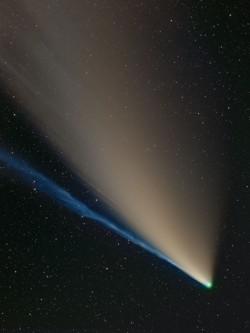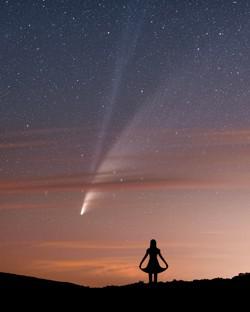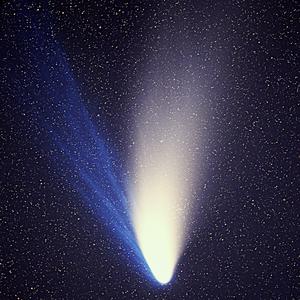Glossary term: Cometary Tail
Description: When a comet is close to the Sun, the Sun's radiation heats up the comet's surface. Ice on the surface turns to gas (it "sublimates"), taking rocky, dusty material with it. The resulting mix forms a cloud around the nucleus of the comet, which is called the coma. In general, a comet will have two tails: The ejected dust particles form the comet's dust tail, which has a characteristically curved shape. It is made up of dust particles released from the surface, which follow the comet along its orbit around the Sun. Dust tails can be millions of kilometers or more in length. They reflect sunlight, and if the conditions are right, their whitish, diffuse shape accounts for most of what can be observed when a comet is visible to the naked eye.
A substantial fraction of the gas is blown away and ionized by the solar wind – the electrically charged particles emitted by the Sun. Those ions form the comet's ion tail, which typically has a blueish color. The ion tail always points straight away from the Sun. If the comet itself is moving away from the Sun, the ion tail precedes the comet.
Related Terms:
See this term in other languages
Term and definition status: This term and its definition have been approved by a research astronomer and a teacher
The OAE Multilingual Glossary is a project of the IAU Office of Astronomy for Education (OAE) in collaboration with the IAU Office of Astronomy Outreach (OAO). The terms and definitions were chosen, written and reviewed by a collective effort from the OAE, the OAE Centers and Nodes, the OAE National Astronomy Education Coordinators (NAECs) and other volunteers. You can find a full list of credits here. All glossary terms and their definitions are released under a Creative Commons CC BY-4.0 license and should be credited to "IAU OAE".
Related Media
Comet C/2020F3 (Neowise) with separate dust and ion gas tails and a green glowing coma, by Dietmar Gutermuth, Germany
Credit: Dietmar Gutermuth/IAU OAE
License: CC-BY-4.0 Creative Commons Attribution 4.0 International (CC BY 4.0) icons
Hello Comet, shall we dance?, by Robert Barsa, Slovakia
Credit: Robert Barsa/IAU OAE
License: CC-BY-4.0 Creative Commons Attribution 4.0 International (CC BY 4.0) icons
Comet Hale-Bopp
Credit: E. Kolmhofer, H. Raab; Johannes-Kepler-Observatory, Linz, Austria credit link
License: CC-BY-SA-3.0 Creative Commons Attribution-ShareAlike 3.0 Unported icons











